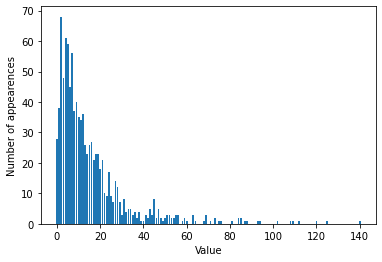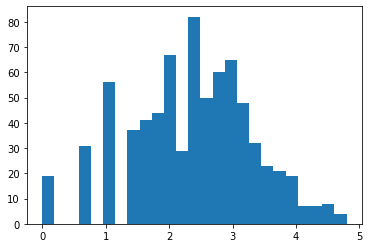数据表示与特征工程--单变量非线性变换
特征和目标之间存在非线性关系,建模变得很困难
⭐log和exp函数可以帮助调节数据的相对比例,改进线性模型或者神经网络的学习效果
⭐大部分模型在每个特征遵循高斯分布时表现很好
⭐在处理整数计数数据时,这种log,exp变换非常有用
1、模拟一些数据
模拟钟形分布的数据
from sklearn.linear_model import Ridge
from sklearn.model_selection import train_test_split
import numpy as np
from matplotlib import pyplot as plt
rnd = np.random.RandomState(0)
X_org = rnd.normal(size=(1000,3))
w = rnd.normal(size=3)
#对X_org应用exp
X = rnd.poisson(10*np.exp(X_org)) #获取泊松分布的随机样本
y = np.dot(X_org,w)
#输出:X_org
'''
```
array([[ 1.76405235, 0.40015721, 0.97873798],
[ 2.2408932 , 1.86755799, -0.97727788],
[ 0.95008842, -0.15135721, -0.10321885],
...,
[-1.30322008, 0.46675065, 0.16110632],
[ 0.32003193, 2.07917666, -0.90746598],
[-0.19240421, -1.21251574, -0.08059852]])
```
'''
#看一下w内容
'''
array([ 1.59327362, 0.5687224 , -0.11448705])`
'''
np.bincount(X[:,0])
'''
array([28, 38, 68, 48, 61, 59, 45, 56, 37, 40, 35, 34, 36, 26, 23, 26, 27,
21, 23, 23, 18, 21, 10, 9, 17, 9, 7, 14, 12, 7, 3, 8, 4, 5,
5, 3, 4, 2, 4, 1, 1, 3, 2, 5, 3, 8, 2, 5, 2, 1, 2,
3, 3, 2, 2, 3, 3, 0, 1, 2, 1, 0, 0, 3, 1, 0, 0, 0,
1, 3, 0, 1, 0, 2, 0, 1, 1, 0, 0, 0, 0, 1, 0, 0, 2,
2, 0, 1, 1, 0, 0, 0, 0, 1, 1, 0, 0, 0, 0, 0, 0, 0,
1, 0, 0, 0, 0, 0, 1, 1, 0, 0, 1, 0, 0, 0, 0, 0, 0,
0, 1, 0, 0, 0, 0, 1, 0, 0, 0, 0, 0, 0, 0, 0, 0, 0,
0, 0, 0, 0, 1], dtype=int64)
'''
bins = np.bincount(X[:,0])
plt.bar(range(len(bins)),bins)
plt.ylabel('Number of appearences')
plt.xlabel('Value')

📣
可以发现X[:,0]呈现泊松分布,X的其他特征也有类似的性质
- 这种类型的数据(许多较小的值和一些非常大的值)在实践中非常常见。
- 但是大多数线性模型无法很好地处理这种数据
2、拟合一个岭回归模型
2.1 原始数据直接应用
X_train, X_test, y_train, y_test = train_test_split(X,y,random_state=0)
score = Ridge().fit(X_train,y_train).score(X_test,y_test)
print("Test score:{}".format(score))
'''
Test score:0.6224186236310756`
'''
📣
rigde无法真正捕捉到X和y的关系 应用对数变换可能有用,由于数据取值包括0,我们不能直接应用log,要计算log(X+1)
2.2 log变换
X_train_log = np.log(X_train+1)
X_test_log = np.log(X_test+1)
plt.hist(X_train_log[:,0],bins=25)

#岭回归
score = Ridge().fit(X_train_log,y_train).score(X_test_log,y_test)
print("Test score:{}".format(score))
'''
Test score:0.8749342372887816`
'''
📣
有时,只对部分数据进行变换,对基于树的模型而言,这种变换不重要,但对线性模型来说至关重要的。
对于复杂度较低的线性模型,分箱、多项式和交互式有很大的提升,对较复杂的模型影响就没那么大了。
基于树的模型通常能够自己发现重要的交互项,大多数情况下不需要显式地变换数据。
⭐对回归的目标变量y进行变换有时也是一个好主意 log(y+1)
3、参考文献
《python机器学习基础教程》
分类:
《Pyhton机器学习基础教程》
标签:
机器学习



【推荐】国内首个AI IDE,深度理解中文开发场景,立即下载体验Trae
【推荐】编程新体验,更懂你的AI,立即体验豆包MarsCode编程助手
【推荐】抖音旗下AI助手豆包,你的智能百科全书,全免费不限次数
【推荐】轻量又高性能的 SSH 工具 IShell:AI 加持,快人一步
· Manus重磅发布:全球首款通用AI代理技术深度解析与实战指南
· 被坑几百块钱后,我竟然真的恢复了删除的微信聊天记录!
· 没有Manus邀请码?试试免邀请码的MGX或者开源的OpenManus吧
· 【自荐】一款简洁、开源的在线白板工具 Drawnix
· 园子的第一款AI主题卫衣上架——"HELLO! HOW CAN I ASSIST YOU TODAY